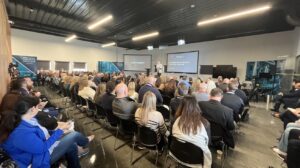
In recent years, we have seen how threat actors are actively going after governmental institutions, such as hospitals, as they’re particularly vulnerable to data breaches. However, the tables have turned in times of the pandemic, and now, regular businesses are the primary target.
Since both large-scale and small-scale enterprises had to adopt work-from-home policies quickly, cybercriminals realized the potential of new attack vectors. Employers no longer have complete control over the networks their employees connect to or the devices they use. So, the risks of attacks grew dramatically.
Even though many employees use security tools on their home devices, it’s often not enough to detect advanced cyber threats. Cyber News talked with Stephen Gold, our Chief Marketing Officer, who explains how businesses can use innovative technologies like artificial intelligence and machine learning to help detect and remotely respond to attacks.
SparkCognition began as a startup in 2013, and now you’re trusted by many businesses worldwide. Would you like to share what the journey was like?
In just over eight years, we’ve experienced substantial growth in all aspects of the business. Our revenues have grown by 90% year over year since 2015, we acquired three businesses in 2021 alone, and we’ve expanded to well over 300 employees globally, with operations in over nine industries. Specific to cybersecurity, we’ve announced partnerships with organizations like Lenovo and Siemens Energy to deliver endpoint protection powered by Artificial Intelligence (AI) for Information Technology (IT) and Operational Technology (OT) applications. This track record has enabled us to continue attracting top talent in AI and cybersecurity.
In January 2022, we announced the close of our $123 million Series D funding round. We achieved a unicorn valuation above $1.4 billion following this round, bringing the total capital raised to $300 million. Along the way, we’ve also continually improved our products through our robust research and development efforts. Our solutions are built using end-to-end AI technology and strengthened by our IP portfolio of over 140 patents, growing by 75% in 2021.
The future is extremely bright with an incredibly talented team, a market CAGR of greater than 31%, and solutions that solve some of the most critical problems businesses face.
Can you tell us about what you do? How is Artificial Intelligence incorporated into your products?
Our solutions are built on our leading-edge technology, including machine learning, deep learning, natural language processing, and knowledge representation. These solutions allow our customers to analyze, optimize, and learn from data, augment human intelligence, drive profitable growth, and achieve operational excellence.
Our next-generation cybersecurity solution, in particular, leverages our patented machine learning techniques to produce models that continually evaluate known and unknown threats – learning and adapting automatically to stay a step ahead of zero-day attacks.
Our cybersecurity solution specifically develops a predictive AI model based on malicious applications and files characteristics instead of relying on signatures, heuristics, or rules-based approaches. It gives security teams the ability to create asset-group-specific security policies to better tailor how you detect and remotely respond to attacks.
How do your solutions differ across various industries?
We combine our patented technology with subject matter expertise to deliver meaningful business outcomes, like higher production throughout, lower energy consumption, and greater worker safety, out of the box. Rather than simply selling technology, our industry and use case-specific SaaS-based solutions are configurable, extensible, and salable, helping accelerate time to deployment, enhance return on investment, and mitigate the uncertainty of technology adoption. They are operationalized specifically to the particular needs of the end-user and industry.
For example, initial models built using our advanced analytics capabilities will be different for renewables, manufacturing, and financial services. Where renewables will be optimized to ensure maximum energy throughput on assets like wind turbines, manufacturing may focus on line efficiency and increasing throughput. The former addresses a $32B problem of energy loss that occurs each year, and the latter can increase output by 20% or more annually.
In cybersecurity, our approach depends on the endpoint we are protecting. The needs of OT assets differ from traditional IT assets. For example, protection for OT infrastructure has a higher need to remain fully functional when there’s no connectivity, or it’s limited. Additionally, OT infrastructure is typically older assets with limited resources.
Has the pandemic presented any new challenges in your field? Did you add any new features?
The pandemic accentuated the need for companies to deal with a very diverse set of challenges. For example, employee turnover created skill gap issues, aging assets needed to be extended due to supply chain issues, meeting Net Zero commitments, or cyber threats needed to be averted. The common denominator is that AI plays a pivotal role in mitigating each of these challenges.
In cybersecurity, TechTarget reported more ransomware activity in the first six months of 2021 than all of 2020 – $590 million and $416M, respectively. Remote work, especially the speed at which it became the norm, presented many new challenges for customers across all industries. As employers no longer had control over the physical locations and networks their employees would work at and connect to, cybersecurity quickly jumped from an already-important investment to an absolutely critical one.
Luckily, we were ready with an award-winning, tested, and trusted solution that helps organizations stay a step ahead of the evolving threat landscape and prevent zero-day attacks, even in situations with limited or no connectivity. After seeing the speed at which remote work was adopted, we continued to develop features like a cloud-based framework, comprehensive virtual training and deployment, and UI optimization that make our solution easier to deploy and manage for a remote workforce. Additionally, we partnered with Siemens Energy to bring the same level of protection to their industrial control systems early in the pandemic.
As work-from-home becomes the new normal, what cybersecurity threats do you see becoming a common occurrence?
Studies have shown that ransomware, phishing, and distributed denial of service (DDoS) attacks continue to be the most prominent threats. We will continue to see an increase in ransomware as attackers leverage new techniques with lucrative outcomes. According to a recent article, ransomware groups focus on critical infrastructure and narrow in on vulnerable corporations. Cybercriminals are preparing for a busy year with more automated attacks, corporate knowledge staffing, and tactics to help them stay out of law enforcement’s sights.
What predictions do you have for AI technology for the next few years?
In the coming years, we can expect to see increased adoption of AI technologies at their core, like Industry 4.0, IoT, autonomous machines, unmanned aerial vehicles (UAVs), robotics, and blockchain applications. With this proliferation, we’ll also see new types of cyber threats emerge, potentially crippling critical infrastructure and services if not prevented. Consequently, SparkCognition remains committed to investing and advancing the next-generation AI-powered cybersecurity, mainly focused on protecting these types of assets.
In your opinion, why do certain companies turn a blind eye when it comes to updating their cybersecurity or trying out new, innovative measures?
Changing and implementing new processes or technologies is difficult, especially when organizations face so many emerging technologies that need to be evaluated for business fit. Decision-makers can quickly get stuck in analysis paralysis. It’s also easy to have the mindset that it won’t happen to me – until it does. This is similar to the mentality of not getting a home alarm until your house gets burglarized.
Early adopters stand to gain the greatest benefit from innovation, providing them a business advantage when it comes to technology adoption and advancement. In this case, a hacker choosing between two targets of equal value is more likely to exploit the organization that is easier to penetrate. AI solutions represent the next line of defense against cyberattacks and thwarting nefarious activity. Businesses of all sizes and orientations can no longer afford to turn a blind eye to the cyber threats they face and the detrimental effect they can have on the organization’s brand, business, and clientele.
Which security solutions do you see taking off in 2022? Which ones are better suited for average individuals and which for large enterprises?
With the growth of IoT and edge computing, endpoint protection (EPP) has never been more critical. SparkCognition EPP can fulfill the security needs of one to thousands, providing a lightweight solution proven to prevent 99.9% of zero-day threats. It protects various endpoints – from IT to OT assets – and leverages machine learning to learn and stay a step ahead of bad actors continually.
We see great opportunities for this solution in 2022 and beyond. As we read the numbers surrounding ransomware and cyberattacks, companies now see the need to protect themselves before becoming a statistic or headline. EPP can help with that by providing anomalous detection protection 24/7.
Would you like to share what’s next for SparkCognition?
Following the close of our Series D funding round and a unicorn valuation, we have a lot to look forward to in 2022. We will continue to build upon our growth (90% CAGR since 2015), investing resources into expanding our existing IP portfolio of 140 patents (up 75% YoY) through research and development around our products and solutions. Particularly, we will focus on AI’s validation and technological advancements at our 50-acre proving ground, HyperWerx. Some of the other key technologies we’ll focus our efforts on are the application of machine learning, deep learning, natural language processing, knowledge representation, visual AI, and more to our customers’ critical problems.
















